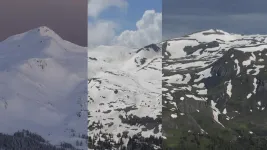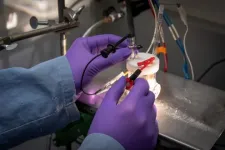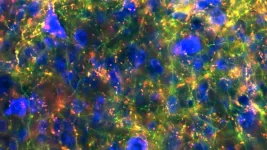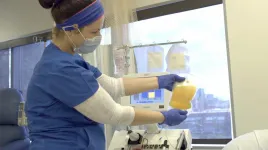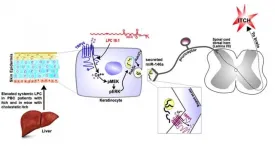(Press-News.org) More snow is melting during winter across the West, a concerning trend that could impact everything from ski conditions to fire danger and agriculture, according to a new University of Colorado Boulder analysis of 40 years of data.
Researchers found that since the late 1970s, winter's boundary with spring has been slowly disappearing, with one-third of 1,065 snow measurement stations from the Mexican border to the Alaskan Arctic recording increasing winter snowmelt. While stations with significant melt increases have recorded them mostly in November and March, the researchers found that melt is increasing in all cold season months--from October to March.
Their new findings, published today in Nature Climate Change, have important implications for water resource planning and may indicate fewer pristine powder days and crustier snow for skiers.
"Particularly in cold mountain environments, snow accumulates over the winter--it grows and grows--and gets to a point where it reaches a maximum depth, before melt starts in the spring," said Keith Musselman, lead author on the study and research associate ,at the Institute of Arctic and Alpine Research (INSTAAR) at the University of Colorado Boulder.
But the new research found that melt before April 1 has increased at almost half of more than 600 stations in western North America, by an average of 3.5% per decade.
"Historically, water managers use the date of April 1 to distinguish winter and spring, but this distinction is becoming increasingly blurred as melt increases during the winter," said Noah Molotch, co-author on the study, associate professor of geography and fellow at INSTAAR.
Snow is the primary source of water and streamflow in western North America and provides water to 1 billion people globally. In the West, snowy mountains act like water towers, reserving water up high until it melts, making it available to lower elevations that need it during the summer, like a natural drip irrigation system.
"That slow trickle of meltwater that reliably occurs over the dry season is something that we have built our entire water infrastructure on in the West," said Musselman. "We rely very heavily on that water that comes down our rivers and streams in the warm season of July and August."
More winter snowmelt is effectively shifting the timing of water entering the system, turning that natural drip irrigation system on more frequently in the winter, shifting it away from the summer, he said.
This is a big concern for water resource management and drought prediction in the West, which depends heavily on late winter snowpack levels in March and April. This shift in water delivery timing could also affect wildfire seasons and agricultural irrigation needs.
Wetter soils in the winter also have ecological implications. One, the wet soils have no more capacity to soak up additional water during spring melt or rainstorms, which can increase flash flooding. Wetter winter soils also keep microbes awake and unfrozen during a time they might otherwise lay dormant. This affects the timing of nutrient availability, water quality and can increase carbon dioxide emissions.
An underutilized data source
Across the western U.S., hundreds of thin, fluid-filled metal pillows are carefully tucked away on the ground and out of sight from outdoor enthusiasts. These sensors are part of an extensive network of long-running manual and automated snow observation stations, which you may have even used data from when looking up how much snow is on your favorite snowshoeing or Nordic skiing trail.
This new study is the first to compile data from all 1,065 automated stations in western North America, providing valuable statistical insight into how mountain snow is changing.
And by using automated, continuously recording snowpack stations instead of manual, monthly observations, the new research shows that winter melt trends are very widespread--at three-times the number of stations with snowpack declines, according to Musselman.
Snowpack is typically measured by calculating how much water will be produced when it melts, known as snow-water equivalent (SWE), which is affected by how much snow falls from the sky in a given season. But because winter snowpack melt is influenced more by temperature than by precipitation, it is a better indicator of climate warming over time.
"These automated stations can be really helpful to understand potential climate change impacts on our resources," said Musselman. "Their observations are consistent with what our climate models are suggesting will continue to happen."
INFORMATION:
Other authors on this publication include Nans Addor at the University of Exeter and Julie Vano at the Aspen Global Change Institute.
Three years ago, scientists at the University of Michigan discovered an artificial photosynthesis device made of silicon and gallium nitride (Si/GaN) that harnesses sunlight into carbon-free hydrogen for fuel cells with twice the efficiency and stability of some previous technologies.
Now, scientists at the Department of Energy's (DOE's) Lawrence Berkeley National Laboratory (Berkeley Lab) - in collaboration with the University of Michigan and Lawrence Livermore National Laboratory (LLNL) - have uncovered a surprising, self-improving property in Si/GaN that contributes to the material's highly efficient and stable performance ...
Thousands of our daily activities, from making coffee to taking a walk to saying hello to a neighbor, are made possible through an ancient collection of brain structures tucked away near the center of the cranium.
The cluster of neurons known as the basal ganglia is a central hub for regulating a vast array of routine motor and behavior functions. But when signaling in the basal ganglia is weakened or broken, debilitating movement and psychiatric disorders can emerge, including Parkinson's disease, Tourette's syndrome, attention deficit hyperactivity disorder (ADHD) and obsessive-compulsive ...
Alzheimer's disease treatments that slow progression of the disease could significantly reduce the financial burden to U.S. state budgets, according to a new USC study.
The study outlines how states -- which have been hit particularly hard by the COVID-19 pandemic -- would see relief: Medicare would cover the costs of treating the disease, while Medicaid expenditures would be reduced due to fewer patients entering nursing homes.
Assuming a 40% relative reduction of Alzheimer's disease progression rates with treatment, researchers projected two decades of savings beginning in 2021, using a simulation model of state Medicaid programs. They forecast annual savings for Medicaid programs of $7.4 billion in 2030; by 2040, the annual savings would be more than $22 billion.
All ...
March 10, 2021 - Hackensack, NJ - Convalescent plasma, the use of survivors' antibodies transfused into sick COVID-19 patients is safe and significantly improves clinical outcomes when using high levels of antibodies, according to a new publication by scientists at Hackensack Meridian Health, New Jersey's largest and most comprehensive health network.
The treatment was safe, transferred the survivors' antibodies, and did not prevent the recipients from making their own antibodies, according to the results published recently in the journal JCI Insights.
"We have developed this technique and methodology to save the lives of patients," said Michele Donato, ...
Public trust in the federal Centers for Disease Control and Prevention has fallen during the coronavirus pandemic, with the decline bringing overall population-level trust in the agency to the same lower level of trust long held by Black Americans about the agency, according to a new RAND Corporation study.
Surveys done among a representative group of Americans in May and October of 2020 show about a 10% decline in trust of the CDC over that period.
In contrast, the same research found that public trust in the U.S. Postal Service and the Federal Emergency Management Agency increased significantly over the period, despite those agencies facing their own challenges.
"The Biden administration will have an uphill ...
New research suggests anxiety among men transitioning into parenthood is significantly higher than reported by the global World Health Organization (WHO) regional prevalence rates.
In a new study published in The Journal of Psychosomatic Obstetrics & Gynecology, researchers from the Colorado School of Public Health on the University of Colorado Anschutz Medical Campus studied the prevalence of anxiety among fathers during the perinatal period, which includes pregnancy through the first year of postpartum.
"The transition to parenthood is a major life event that's often accompanied with new challenges related to financial, relationship, and work-life balance concerns. Despite those changes happening for both men and women, not much is known about the prevalence of anxiety ...
The diffraction limit, also known as Abbe diffraction limit in optics, poses a great challenge in many systems that involve wave dynamics, such as imaging, astronomy, and photolithography. For example, the best optical microscope only possesses resolution around 200 nm, but the physical size of the photolithography process with an excimer laser is around tens of nanometers. Meanwhile, physical sizes in current research and applications in biology and the semiconductor industry have scaled down to several nanometers, which is far beyond the ability of optical waves. According ...
A new publication from the Dauphin Island Sea Lab's Marine Mammal Research Program (DISL) examines how bridge-building and in-water construction activities may affect manatees and other large aquatic species. The article, which was recently published in END ...
ORLANDO, April 5, 2021 - A new study from the University of Central Florida suggests that masks and a good ventilation system are more important than social distancing for reducing the airborne spread of COVID-19 in classrooms.
The research, published recently in the journal Physics of Fluids, comes at a critical time when schools and universities are considering returning to more in-person classes in the fall.
"The research is important as it provides guidance on how we are understanding safety in indoor environments," says Michael Kinzel, an assistant professor in UCF's Department of Mechanical and Aerospace Engineering and study co-author.
"The study finds that aerosol transmission routes do not display ...
DURHAM, N.C. - A devastating itching of the skin driven by severe liver disease turns out to have a surprising cause. Its discovery points toward possible new therapies for itching, and shows that the outer layer of the skin is so much more than insulation.
The finding, which appears April 2 in Gastroenterology, indicates that the keratinocyte cells of the skin surface are acting as what lead researcher Wolfgang Liedtke, MD PhD, calls 'pre-neurons.'
"The skin cells themselves are sensory under certain conditions, specifically the outermost layer of cells, the keratinocytes," said Liedtke, who is a professor of neurology ...
